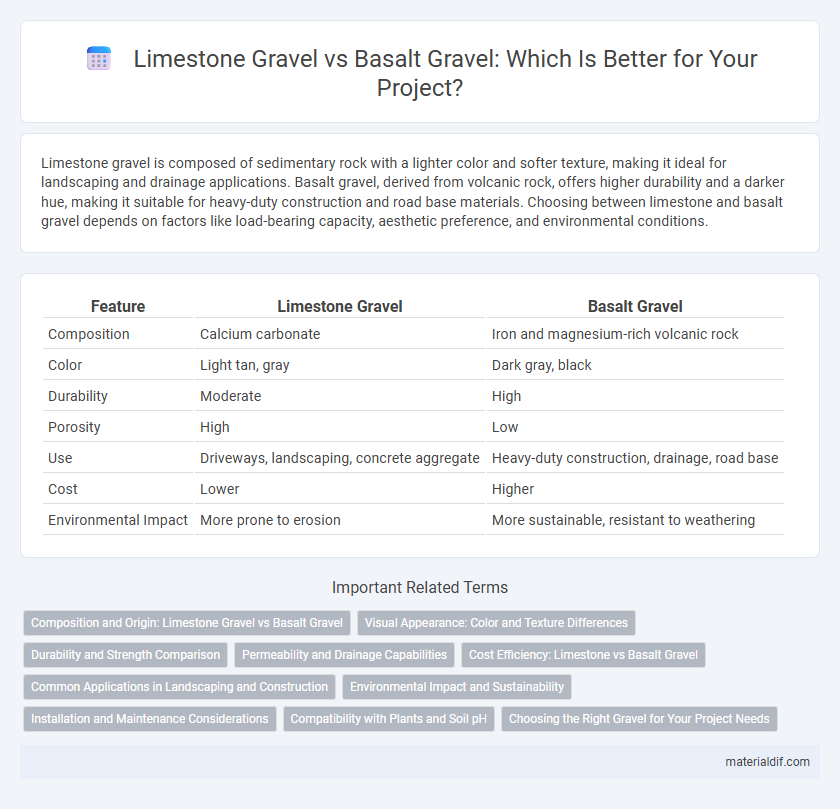Limestone gravel is composed of sedimentary rock with a lighter color and softer texture, making it ideal for landscaping and drainage applications. Basalt gravel, derived from volcanic rock, offers higher durability and a darker hue, making it suitable for heavy-duty construction and road base materials. Choosing between limestone and basalt gravel depends on factors like load-bearing capacity, aesthetic preference, and environmental conditions.
Table of Comparison
| Feature | Limestone Gravel | Basalt Gravel |
|---|---|---|
| Composition | Calcium carbonate | Iron and magnesium-rich volcanic rock |
| Color | Light tan, gray | Dark gray, black |
| Durability | Moderate | High |
| Porosity | High | Low |
| Use | Driveways, landscaping, concrete aggregate | Heavy-duty construction, drainage, road base |
| Cost | Lower | Higher |
| Environmental Impact | More prone to erosion | More sustainable, resistant to weathering |
Composition and Origin: Limestone Gravel vs Basalt Gravel
Limestone gravel is primarily composed of calcium carbonate derived from sedimentary rock formed in marine environments, while basalt gravel consists of dense, fine-grained igneous rock rich in iron and magnesium formed from cooled lava flows. The sedimentary origin of limestone results in a softer, more porous texture compared to the harder, more durable volcanic basalt gravel. These compositional and geological differences influence their suitability for construction, drainage, and landscaping applications.
Visual Appearance: Color and Texture Differences
Limestone gravel typically features a light, creamy-white to gray color with a smooth, fine texture that enhances its clean and polished appearance. Basalt gravel contrasts sharply with deep black to dark gray shades and a coarse, rough texture, creating a bold, rugged look. These visual differences significantly impact landscaping or construction aesthetics, where limestone offers brightness and subtlety and basalt provides dramatic contrast and texture.
Durability and Strength Comparison
Limestone gravel exhibits moderate durability with a tendency to wear down under heavy traffic and weathering, making it suitable for lighter construction projects. Basalt gravel offers superior strength and resistance to abrasion, maintaining its integrity under harsh conditions and heavy loads. The higher compressive strength and dense nature of basalt gravel make it an optimal choice for high-performance road bases and industrial applications.
Permeability and Drainage Capabilities
Limestone gravel exhibits higher permeability due to its porous nature, allowing water to drain quickly and efficiently, making it ideal for drainage systems and erosion control. Basalt gravel, being denser and less porous, has lower permeability, resulting in slower water drainage but offering superior compaction and stability for construction foundations. The choice between limestone and basalt gravel depends on the specific drainage requirements and load-bearing needs of a project.
Cost Efficiency: Limestone vs Basalt Gravel
Limestone gravel typically offers greater cost efficiency compared to basalt gravel due to its lower extraction and processing expenses. Basalt gravel, while more durable and dense, incurs higher transportation and installation costs, impacting overall project budgets. Selecting limestone gravel can reduce upfront costs, making it a preferred choice for large-scale landscaping and construction projects where budget constraints are critical.
Common Applications in Landscaping and Construction
Limestone gravel is frequently used in landscaping for garden paths, driveways, and decorative ground cover due to its light color and ease of compaction, promoting good drainage and a polished appearance. Basalt gravel, known for its durability and dark coloration, is preferred in construction projects requiring strong foundational support such as road bases, concrete aggregates, and erosion control. Both materials enhance structural integrity but cater to different aesthetic and functional requirements based on their unique physical properties.
Environmental Impact and Sustainability
Limestone gravel generally exhibits lower environmental impact due to its abundant availability and easier extraction process, which reduces energy consumption and habitat disruption compared to basalt gravel. Basalt gravel, while more durable, requires higher energy for quarrying and processing, resulting in greater carbon emissions and potential ecosystem disturbances. Sustainable practices favor limestone gravel for road construction and landscaping where environmental conservation and resource efficiency are priorities.
Installation and Maintenance Considerations
Limestone gravel offers easier installation due to its softer texture, allowing faster compaction and shaping for driveways or pathways, while basalt gravel requires heavier machinery because of its hardness and density. Maintenance for limestone gravel involves more frequent replenishment and weed control since it tends to break down and compact over time, whereas basalt gravel remains stable longer, reducing upkeep needs. Choosing the right gravel depends on the project's durability requirements and willingness to invest in ongoing maintenance efforts.
Compatibility with Plants and Soil pH
Limestone gravel, composed mainly of calcium carbonate, tends to raise soil pH, making it ideal for plants that thrive in alkaline conditions such as lavender and rosemary. Basalt gravel is more acidic and neutral in nature, suitable for acidic to neutral soils and compatible with plants like azaleas and blueberries. Choosing the appropriate gravel depends on matching the gravel's pH influence with the specific requirements of the plant species and existing soil chemistry to ensure optimal growth and soil health.
Choosing the Right Gravel for Your Project Needs
Limestone gravel, composed primarily of calcium carbonate, offers excellent drainage and a smoother texture ideal for landscaping and decorative pathways, while basalt gravel is denser, more durable, and favored for high-traffic construction projects due to its superior strength and resistance to weathering. The choice between limestone and basalt gravel depends on project requirements such as load-bearing capacity, aesthetic preferences, and budget considerations. For erosion control and stable foundation bases, basalt gravel provides enhanced compressive strength, whereas limestone gravel is preferred for lighter landscaping and aquatic filtration applications.
Limestone Gravel vs Basalt Gravel Infographic

 materialdif.com
materialdif.com